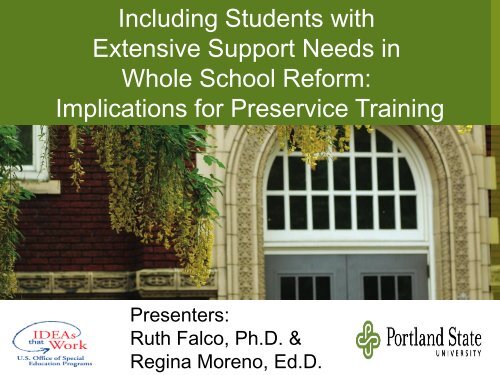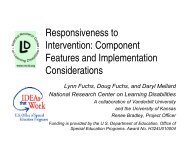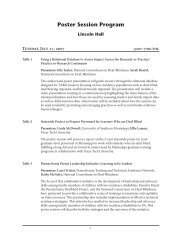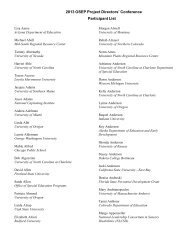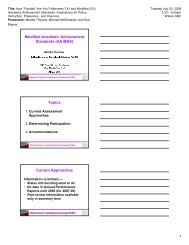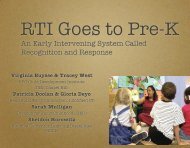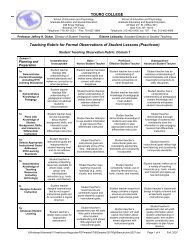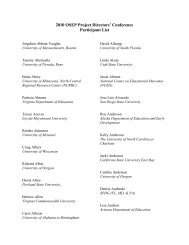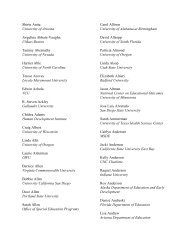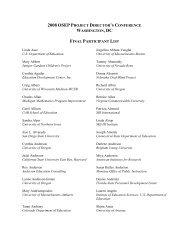Including Students with Extensive Support Needs in Whole School ...
Including Students with Extensive Support Needs in Whole School ...
Including Students with Extensive Support Needs in Whole School ...
Create successful ePaper yourself
Turn your PDF publications into a flip-book with our unique Google optimized e-Paper software.
<strong>Includ<strong>in</strong>g</strong> <strong>Students</strong> <strong>with</strong><br />
<strong>Extensive</strong> <strong>Support</strong> <strong>Needs</strong> <strong>in</strong><br />
<strong>Whole</strong> <strong>School</strong> Reform:<br />
Implications for Preservice Tra<strong>in</strong><strong>in</strong>g<br />
Presenters:<br />
RR<br />
Ruth Falco, Ph.D. &<br />
Reg<strong>in</strong>a Moreno, Ed.D.
The contents of this presentation were<br />
developed under a grant from the<br />
Department of Education, #H325K080217.<br />
However, those contents do not necessarily<br />
represent the policy of the US Department of<br />
Education, and you should not assume<br />
endorsement by the Federal Government.<br />
Project Officer, Shedeh Hajghassemali, Ph.D.
Why the Interest <strong>in</strong> <strong>Whole</strong><br />
<strong>School</strong> Reform<br />
• Plans for reauthorization of ESEA<br />
challenge schools to support all students<br />
by provid<strong>in</strong>g –<br />
• Evidence-based <strong>in</strong>struction<br />
• Access to challeng<strong>in</strong>g curriculum<br />
• Preparation for college & careers<br />
• <strong>Whole</strong> school reform is an effective,<br />
systemic approach to address<strong>in</strong>g school<br />
change (Tucci, 2009; Waldron &<br />
McLeskey, 2010)
<strong>School</strong> Reform and <strong>Students</strong><br />
<strong>with</strong> <strong>Extensive</strong> <strong>Support</strong> <strong>Needs</strong><br />
Research-to-Practice Gap - <strong>Students</strong><br />
<strong>with</strong> <strong>Extensive</strong> <strong>Support</strong> <strong>Needs</strong> (ESN)<br />
cont<strong>in</strong>ue to need access to:<br />
• General education curriculum <strong>in</strong><br />
general education classes<br />
• Peer relationships/supports<br />
• <strong>School</strong>-wide systems of support<br />
(UDL/AT, RTI, PBIS)<br />
• Parent <strong>in</strong>volvement<br />
• Teachers <strong>with</strong> susta<strong>in</strong>ed commitment<br />
to leadership and advocacy for<br />
<strong>in</strong>clusive education for all students
<strong>School</strong> Reform and <strong>Students</strong><br />
<strong>with</strong> <strong>Extensive</strong> <strong>Support</strong> <strong>Needs</strong><br />
• <strong>Whole</strong> school reform can address<br />
research-to-practice gap for students <strong>with</strong><br />
ESN & improve schools -<br />
• Establish leadership dynamics for<br />
<strong>in</strong>clusive service delivery (Scanlan, 2009)<br />
• Establish a collaborative school culture<br />
(Waldron & McLeskey, 2010)<br />
• Establish <strong>in</strong>clusive schools through<br />
school-university partnerships (Causton-<br />
Theoharis, et al., 2010; McSheehan, et al., 2006)<br />
• Integrate specialized practices to<br />
enhance learn<strong>in</strong>g for all students (Sailor &<br />
Roger, 2005)
Implications for Preservice<br />
Tra<strong>in</strong><strong>in</strong>g – Requires:<br />
• Preservice curriculum provid<strong>in</strong>g<br />
current knowledge & skills:<br />
• Universal Design for Learn<strong>in</strong>g (UDL) &<br />
Assistive Technology (AT)<br />
• Evidence Based Practices (EBP) for<br />
students <strong>with</strong> ESN<br />
• Integrated cl<strong>in</strong>ical practica support<strong>in</strong>g<br />
use of knowledge of UDL, AT & EBP<br />
<strong>with</strong> students <strong>with</strong> ESN<br />
• Knowledge & skills for teacher<br />
leadership & advocacy to susta<strong>in</strong><br />
teachers <strong>in</strong> field
Questions for Review of PSU<br />
Special Educator Program<br />
• Does the PSU Special Educator Program<br />
provide:<br />
• EBP for <strong>in</strong>clusion of students <strong>with</strong> ESN<br />
<strong>in</strong> school reform<br />
•UDL/AT (as well as RTI/PBIS)<br />
•Evidence-based teach<strong>in</strong>g strategies<br />
for students <strong>with</strong> ESN<br />
•Knowledge and skills for leadership &<br />
advocacy<br />
• Integrated cl<strong>in</strong>ical practica to support<br />
application of EBP for students <strong>with</strong><br />
ESN <strong>in</strong> <strong>in</strong>clusive schools
PSU Special Educator Program Review:<br />
Methods<br />
Analysis of<br />
course syllabi<br />
Discussions <strong>with</strong><br />
faculty and<br />
stakeholders<br />
Review of<br />
the literature<br />
Evaluation of<br />
field experience<br />
sites<br />
Context for<br />
PSU<br />
Special<br />
Educator<br />
Program<br />
Interviews and<br />
observations of<br />
scholars/teacher<br />
candidates
Context for Preservice Program<br />
Review at PSU<br />
• Generalist Special Educator Program<br />
• PSU history of strong program for<br />
specialists <strong>in</strong> education for students <strong>with</strong><br />
significant disabilities, but shift<strong>in</strong>g<br />
perspectives on priorities<br />
• 325T Project focused on Evidence Based<br />
Practices (EBP) for students <strong>with</strong> high<br />
<strong>in</strong>cidence disabilities<br />
• Personnel Development Project (Futures)<br />
focused on <strong>in</strong>tegrat<strong>in</strong>g EBP for students<br />
<strong>with</strong> <strong>Extensive</strong> <strong>Support</strong> <strong>Needs</strong> (ESN)*
PSU Special Education<br />
Curriculum Committee<br />
Key committee members:<br />
Amanda Sanford, Chair<br />
Susan Bert<br />
Reg<strong>in</strong>a Moreno*<br />
Tiffany Jones<br />
Chris Borgmeier<br />
Ruth Falco*<br />
Julie Esparza-Brown<br />
Leslie Munson
Inclusion of <strong>Students</strong> <strong>with</strong> ESN<br />
<strong>in</strong> <strong>Whole</strong> <strong>School</strong> Reform<br />
Important practices identified through literature:<br />
• Access to curriculum <strong>in</strong> general education classes<br />
• UDL and <strong>in</strong>tegrated use of AT<br />
• <strong>School</strong>-wide Response to Intervention (RTI) & <strong>School</strong>wide<br />
Positive Behavior Intervention and <strong>Support</strong> (PBIS)<br />
• Environmental supports, <strong>in</strong>clud<strong>in</strong>g peer supports<br />
• Person-centered plann<strong>in</strong>g/<strong>Support</strong>s for selfdeterm<strong>in</strong>ation<br />
• Family <strong>in</strong>volvement<br />
• Evidence-based, systematic <strong>in</strong>struction (EBP) for all:<br />
• Flexible group<strong>in</strong>gs<br />
• Individualized environmental supports<br />
• Individualized EB teach<strong>in</strong>g strategies<br />
• Progress monitor<strong>in</strong>g
Analysis of Course Syllabi for<br />
Important Practices<br />
• Analysis of Special Educator Program courses:<br />
• Consistent term<strong>in</strong>ology used across courses<br />
• Limited evidence<br />
• Address important practices for <strong>in</strong>clusion of<br />
students <strong>with</strong> ESN<br />
• Limited evidence (except for 3 courses focused<br />
on students <strong>with</strong> ESN)<br />
• Academic, standards-based, core-content courses<br />
address EBP for students <strong>with</strong> ESN (except 3<br />
courses focused on students <strong>with</strong> ESN)<br />
• Lecture content – Limited evidence<br />
• Course work assignments – Highly limited<br />
evidence<br />
• Field-experience tasks – Highly limited evidence<br />
• Teacher candidate evaluations – Highly limited<br />
evidence
Special Educator Program<br />
Faculty Survey<br />
Themes from suggestions made by faculty regard<strong>in</strong>g<br />
students <strong>with</strong> ESN:<br />
• Increase focus on school-wide systems of support:<br />
RTI, PBIS, UDL<br />
• Expand content on students <strong>with</strong> ESN across courses,<br />
<strong>in</strong>clud<strong>in</strong>g academic, core-content methods courses<br />
• Literacy, writ<strong>in</strong>g and math methods coursework<br />
• Functional academics across courses<br />
• Understand<strong>in</strong>g of systematic and differentiated <strong>in</strong>struction<br />
• Use of <strong>in</strong>dividualized data-based decision-mak<strong>in</strong>g<br />
• Behavior management for students <strong>with</strong> ESN<br />
• EBP for students <strong>with</strong> autism spectrum disorder<br />
• ELL and students <strong>with</strong> diverse backgrounds <strong>with</strong> ESN<br />
• Expand focus on teachers as leaders and advocates<br />
• Plann<strong>in</strong>g and work<strong>in</strong>g <strong>with</strong> paraeducators<br />
• Sett<strong>in</strong>g up classrooms and case management<br />
• Develop<strong>in</strong>g IEPs and lead<strong>in</strong>g meet<strong>in</strong>gs<br />
• Us<strong>in</strong>g alternative assessment systems<br />
• Add credit to Work Sample sem<strong>in</strong>ar courses to better<br />
<strong>in</strong>tegrate course work & application <strong>in</strong> practicum
Special Educator Program<br />
Discussion <strong>with</strong> LEA Leaders<br />
• Examples of themes from suggestions of LEA<br />
leaders for curriculum/competencies:<br />
• RTI, PBIS, Environmental <strong>Support</strong>s for all<br />
• EBP for students <strong>with</strong> ESN, such as those<br />
<strong>with</strong> ASD and ID – Examples:<br />
• Task analysis,systematic <strong>in</strong>struction & prompt<strong>in</strong>g<br />
• Individualized data collection methods<br />
• Person-centered plann<strong>in</strong>g, family support<br />
• Leadership – Examples:<br />
• Work<strong>in</strong>g <strong>with</strong> teams and paraeducators<br />
• On-go<strong>in</strong>g tra<strong>in</strong><strong>in</strong>g for paraeducators<br />
• Team management & problem-solv<strong>in</strong>g
Opportunities for Integrated<br />
Practicum Experiences<br />
• Surveys of practices for students <strong>with</strong> ESN<br />
observed by 2010-11 Teacher Candidates<br />
& Supervisors <strong>in</strong> practicum experiences:<br />
• Most consistently observed practices–<br />
• <strong>Support</strong><strong>in</strong>g paraeducators<br />
• Organization and schedul<strong>in</strong>g<br />
• Student engagement and positive classroom<br />
climate<br />
• Somewhat consistently observed practices –<br />
• Effective <strong>in</strong>struction<br />
• Positive behavior support<br />
• Student physical management
Opportunities for Integrated<br />
Practicum Experiences<br />
• Surveys (candidates & supervisors) of<br />
observed practices for students <strong>with</strong> ESN:<br />
• Inconsistently or rarely observed practices –<br />
•Collaboration between special and general<br />
education teachers<br />
•Access to academic, standards-based<br />
curriculum <strong>in</strong> general education classes<br />
•Access to non-academic curriculum <strong>in</strong><br />
general education classes<br />
•Use of supports for peer <strong>in</strong>teraction<br />
•Use of AT/AAC devices <strong>in</strong> general<br />
education classes
Outcomes of Program Review<br />
• Collaboration of all Special Education<br />
Faculty <strong>in</strong> a process of curriculum reform<br />
• Development of set of Critical Concepts to<br />
be addressed across all courses<br />
• Revisions of all syllabi <strong>in</strong>tended to:<br />
•Address Critical Concepts<br />
•Address full cont<strong>in</strong>uum of learners<br />
•Address other areas of need (e.g.,<br />
diversity and use of technology)<br />
• Efforts to improve <strong>in</strong>tegration of practica<br />
experiences and address full cont<strong>in</strong>uum of<br />
learners (Collaboration <strong>with</strong> LEA Partners)
Outcomes of Review:<br />
Critical Concepts<br />
Scaffold<strong>in</strong>g Instruction – Use of temporary flexible prompted<br />
supports faded towards <strong>in</strong>dependence<br />
Data-Based Decision Mak<strong>in</strong>g - Cont<strong>in</strong>uous, purposeful process<br />
<strong>in</strong> consideration of student learn<strong>in</strong>g across school sett<strong>in</strong>gs<br />
Individualization – Systematic process to meet the educational,<br />
cultural and diverse needs of students and their families<br />
Collaboration &Team<strong>in</strong>g – Dynamic and effective mutual effort<br />
across stakeholders <strong>in</strong> jo<strong>in</strong>t accountability for mean<strong>in</strong>gful<br />
student outcomes<br />
Inclusion – Full membership for all learners<br />
Leadership & Advocacy – Teacher-leaders as role models,<br />
change agents and resources for promot<strong>in</strong>g positive student<br />
outcomes
Outcomes of Program Review:<br />
Revised Course Sequence
Outcomes of Program Review:<br />
Initial Revised Syllabi<br />
• Positive changes <strong>in</strong> course work syllabi:<br />
• Language across all courses refers to a<br />
“full cont<strong>in</strong>uum of learners”<br />
• More courses <strong>in</strong>clude lecture/assignment<br />
elements address<strong>in</strong>g students <strong>with</strong> ESN -<br />
•3 of the 17 had this content already<br />
•5 of 17 added substantial content<br />
•5 of 17 added some content<br />
•4 of 17 cont<strong>in</strong>ue to have no focus<br />
• Increased field experience credits &<br />
ma<strong>in</strong>ta<strong>in</strong>ed credits for courses <strong>with</strong> specific<br />
focus on students <strong>with</strong> ESN
Outcomes of Program Review:<br />
Initial Revised Syllabi<br />
• Cont<strong>in</strong>u<strong>in</strong>g needs<br />
• Increased content and assignments<br />
address<strong>in</strong>g EBP for students <strong>with</strong> ESN<br />
• Increased collaboration of faculty to<br />
expand focus of syllabi and assignments<br />
• Focus on students <strong>with</strong> ESN <strong>in</strong> Diagnostic<br />
Assessment course<br />
• Better <strong>in</strong>formation and support to adjunct<br />
faculty<br />
• Cont<strong>in</strong>ued conversations among faculty to<br />
expand course content and EBP across<br />
full cont<strong>in</strong>uum of learners
Outcomes of Program Review:<br />
Practica<br />
• Positive changes across all field experience:<br />
• Increased practica credits from 6 to 9 and<br />
student teach<strong>in</strong>g credits from 12 to 15<br />
• Cumulative knowledge and activity<br />
checklists for practica and student<br />
teach<strong>in</strong>g ensure comprehensive<br />
experiences across the full cont<strong>in</strong>uum of<br />
learners<br />
• Teacher candidates use a portfolio/<br />
practicum notebook to compile evidence<br />
of activities across cont<strong>in</strong>uum of learners<br />
• Pre-observation, observation & evaluation<br />
forms <strong>in</strong>clude focus on students <strong>with</strong> ESN
Outcomes: Integration of<br />
Course Work & Practica<br />
• Classroom Practice Checklists for students<br />
<strong>with</strong> ESN (Used by field supervisors,<br />
expert faculty and teacher candidates)<br />
• Revised Practicum Observation and<br />
Evaluation Forms (across cont<strong>in</strong>uum of<br />
students)<br />
• Improvements <strong>in</strong> requirements for Work<br />
Sample focused on students <strong>with</strong> ESN<br />
• Revised Supervisor orientation & tra<strong>in</strong><strong>in</strong>g<br />
process (across cont<strong>in</strong>uum)
Work Sample outcomes W<strong>in</strong>ter 12<br />
N=26<br />
Sections<br />
Exemplary Proficient Emerg<strong>in</strong>g Unsatisfactory<br />
(Major<br />
revisions)<br />
Total<br />
<strong>in</strong>itial<br />
Revision<br />
Context 19 4 3 0 3<br />
IEP<br />
Developmt.<br />
Instructional<br />
Plan<br />
Data on<br />
learn<strong>in</strong>g<br />
Ga<strong>in</strong>s<br />
14 6 5 1 6<br />
18 7 1 0 1<br />
14 9 2 1 3<br />
Interpret &<br />
expla<strong>in</strong> • the<br />
data<br />
18 3 4 1 5
Outcomes: Integration of<br />
Course Work & Practica<br />
• 2/3rds of Teacher Candidates raised their<br />
rat<strong>in</strong>gs from proficiency to exemplary,<br />
after revisions<br />
• Implementation of work samples resulted<br />
<strong>in</strong> improvements <strong>in</strong> outcomes for<br />
students <strong>with</strong> ESN taught by teacher<br />
candidates:<br />
• 21/26 focus students made noteworthy<br />
ga<strong>in</strong>s (Decrease of at least two prompt<br />
levels or <strong>in</strong>creased performance of<br />
50% over basel<strong>in</strong>e)
Outcomes of Program Review:<br />
Practica<br />
• Cont<strong>in</strong>u<strong>in</strong>g needs<br />
• Improve access to students <strong>with</strong> ESN who<br />
are <strong>in</strong>cluded <strong>in</strong> general education classes<br />
•In 2011-12 only 6 of 24 full-time<br />
Teacher Candidates worked <strong>with</strong><br />
students <strong>with</strong> ESN <strong>in</strong> general ed classes<br />
• Greater awareness across faculty of ways<br />
to <strong>in</strong>corporate practicum activities & tasks<br />
relevant to students <strong>with</strong> ESN <strong>in</strong> course<br />
assignments<br />
• Increase focus on students <strong>with</strong> ESN <strong>in</strong><br />
“Start of the <strong>School</strong> Year” practicum/class
Next Steps -<br />
• Cont<strong>in</strong>ue faculty conversations regard<strong>in</strong>g<br />
Critical Concepts across cont<strong>in</strong>uum of learners<br />
• Cont<strong>in</strong>ue & expand collaboration among faculty<br />
to expand curricula, assignments & practica<br />
activities across cont<strong>in</strong>uum of learners<br />
• Build stronger partnerships <strong>with</strong> targeted LEAs<br />
and expand professional development for LEA<br />
educators<br />
• UDL/AT/RTI/PBIS to benefit all learners<br />
• Access to general education curriculum <strong>in</strong><br />
general ed classes for students <strong>with</strong> ESN<br />
• Integrate EBP for students <strong>with</strong> ESN
<strong>Includ<strong>in</strong>g</strong> <strong>Students</strong> <strong>with</strong> ESN<br />
In <strong>Whole</strong> <strong>School</strong> Reform<br />
• All students benefit when students <strong>with</strong> ESN<br />
are <strong>in</strong>cluded <strong>in</strong> whole school reform (Sailor &<br />
Roger, 2005) by enhanced:<br />
• <strong>School</strong>-wide systems of support (UDL/AT,<br />
RTI, PBIS)<br />
• EBP to support learn<strong>in</strong>g of all students<br />
• Peer relationships/supports<br />
• Commitment of teachers to leadership and<br />
advocacy for <strong>in</strong>clusive education for all<br />
• To achieve these reforms, preservice<br />
education for special educators must be<br />
reformed
Discussion Questions:<br />
• How successfully are students <strong>with</strong> ESN<br />
<strong>in</strong>cluded <strong>in</strong> whole school reform <strong>in</strong> your<br />
area<br />
• How are preservice special educators<br />
learn<strong>in</strong>g to enhance these efforts<br />
• How do LEA partnerships enhance these<br />
efforts<br />
• What are the challenges and barriers we<br />
face <strong>in</strong> prepar<strong>in</strong>g preservice special<br />
educators to <strong>in</strong>clude students <strong>with</strong> ESN <strong>in</strong><br />
whole school reform<br />
• What strategies help to overcome the<br />
barriers
References<br />
Causton-Theoharis, J., Theoharis, G., Bull, T., Cosier, M., & Dempf-<br />
Aldrich, K. (2010). <strong>School</strong>s of promise: A school district –<br />
University partnership centered on <strong>in</strong>clusive school reform.<br />
Remedial and Special Education, 32: 192 orig<strong>in</strong>ally published<br />
onl<strong>in</strong>e 30 March 2010.<br />
McSheehan, M., Sonnenmeier, R.M., Jorgensen, C.M., & Turner, K.<br />
(2006). Beyond communication access: Promot<strong>in</strong>g learn<strong>in</strong>g of the<br />
general education curriculum by students <strong>with</strong> significant<br />
disabilities. Topics <strong>in</strong> Language Disorders, 26(3), 266-290.<br />
Sailor, W., & Roger, B. (2005 ). Reth<strong>in</strong>k<strong>in</strong>g <strong>in</strong>clusion: <strong>School</strong>-wide<br />
applications. Phi Delta Kappan, March, 503-509.<br />
Scanlan, M. (2009 ). Leadership dynamics promot<strong>in</strong>g systemic<br />
reform for <strong>in</strong>clusive service delivery. Journal of <strong>School</strong><br />
Leadership, 19, 622-660.<br />
Tucci, T.N. (2009). <strong>Whole</strong> school reform: Transform<strong>in</strong>g the nation’s<br />
low-perform<strong>in</strong>g high schools. Wash<strong>in</strong>gton, D.C.: Alliance for<br />
Excellent Education.<br />
Waldron, N.L., & McLeskey, J. (2010). Establish<strong>in</strong>g a collaborative<br />
school culture through comprehensive school reform. Journal of<br />
Educational and Psychological Consultation, 20, 58-74.


